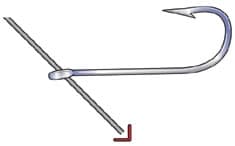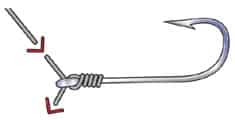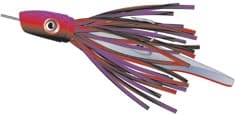
Strip baits are deadly on a wide range of offshore game fish, most notably dolphin, sailfish, wahoo and tuna. They are extremely versatile baits, performing well at a variety of trolling speeds, and are easy to rig and store. They also make great teasers when rigged without a hook.
The strips can be cut from the belly skin of a baitfish, such as a bonito, or made of soft plastic. Some anglers even make their strips from old vinyl car seats. To modify the bait’s action, try splitting the tail of the bait, adding a sinker in front of the strip, or experimenting with different skirts and lure heads.
The following is a quick and easy way to rig a strip bait, be it natural or plastic. Unless you’re after blue marlin or bluefin tuna, the following materials can be used: six to ten feet of No. 8 leader wire, a single 7/0 or 8/0 long-shank, ring-eye hook and copper rigging wire.
| Step 1 ¿Pass approximately six inches of the wire leader through the hook eye. |

|Step 2 ¿Make three or four very tight wraps around the hook shank, then pass the wire through the eye.|

|Step 3 ¿Make several tight haywire twists as close to the eye as possible. Finish the connection with several barrel wraps, making sure the end of the wire points toward the point of the hook. Add the copper rigging wire to the leader, just in front of the hook eye.|

|Step 4 ¿ With a natural bait, lay the rig flat against the meat side. The wire “pin” should sit about a quarter-inch behind the head of the strip. Once centered, press the hook firmly against the meat, creating an imprint. On a plastic strip, use a pen or magic marker to note the spot where the hook shank begins to bend.|

|Step 5 ¿Push the wire pin and copper wire through the strip. Pass the hook point through the meat at the spot where the hook begins to bend.|

|Step 6 ¿With the pin and hook shank firmly positioned and centered on the strip, wrap the rigging wire behind the pin and around the leader. The exposed pin should then be trimmed and bent back toward the tail, which helps hold the copper wraps in place. The strip is now ready to be fished.Another option is to forego the copper wrap and instead sharply bend the tag end toward the strip’s head. Then form a smaller, sharper bend in the end of the pin, which can be clipped onto the leader.|

|Step 7 ¿While strip baits can be fished “naked,” most anglers slip a skirt or trolling lure over the tip of the bait.|









